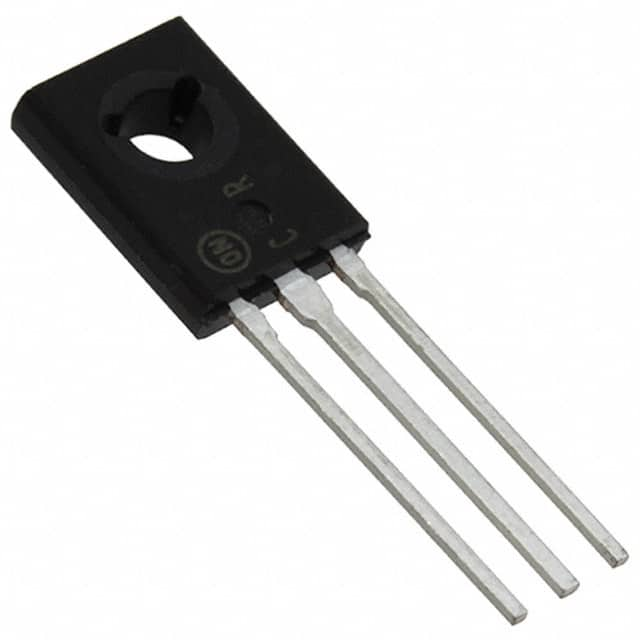Lihat spesifikasi untuk detail produk.

BD437 Transistor
Product Overview
Category
The BD437 transistor belongs to the category of NPN bipolar junction transistors.
Use
It is commonly used for amplification and switching applications in electronic circuits.
Characteristics
- Low power, high voltage capability
- Medium current capability
- High transition frequency
- Low saturation voltage
Package
The BD437 transistor is typically available in a TO-126 package.
Essence
This transistor is essential for various electronic devices and circuit designs.
Packaging/Quantity
It is usually packaged in reels or tubes, with quantities varying based on manufacturer specifications.
Specifications
- Collector-Emitter Voltage (VCEO): 45V
- Collector-Base Voltage (VCBO): 45V
- Emitter-Base Voltage (VEBO): 5V
- Collector Current (IC): 4A
- Power Dissipation (PD): 36W
- Transition Frequency (ft): 40MHz
- Operating Temperature: -65°C to 150°C
Detailed Pin Configuration
The BD437 transistor has three pins: 1. Collector (C) 2. Base (B) 3. Emitter (E)
Functional Features
- High voltage capability
- Low power consumption
- Fast switching speed
- Reliable performance in various circuit configurations
Advantages
- Suitable for low-power applications
- Versatile usage in amplification and switching circuits
- Robust construction for reliable operation
Disadvantages
- Limited current handling capacity compared to higher power transistors
- Sensitive to temperature variations
Working Principles
The BD437 operates based on the principles of bipolar junction transistors, utilizing the control of current flow between its terminals to amplify or switch electronic signals.
Detailed Application Field Plans
Amplification Circuits
The BD437 transistor is widely used in audio amplifiers, signal amplification stages, and other low-power amplification circuits.
Switching Applications
It finds application in various electronic switches, relay drivers, and pulse generation circuits due to its fast switching characteristics.
Oscillator Circuits
In oscillator circuits, the BD437 can be employed for generating stable oscillations at moderate frequencies.
Detailed and Complete Alternative Models
- BD435
- BD436
- BD438
- 2N3055
- TIP31
In conclusion, the BD437 transistor offers a balance of voltage and current capabilities suitable for a wide range of electronic applications, making it a popular choice among hobbyists and professionals alike.
Word Count: 345
Sebutkan 10 pertanyaan dan jawaban umum terkait penerapan BD437 dalam solusi teknis
What is BD437?
- BD437 is a PNP silicon epitaxial-base transistor commonly used for general-purpose amplification and switching applications.
What are the typical applications of BD437?
- BD437 is often used in audio amplifiers, voltage regulators, relay drivers, and other low-power switching applications.
What are the key electrical characteristics of BD437?
- The key electrical characteristics of BD437 include a maximum collector current of 1A, a maximum collector-emitter voltage of 45V, and a maximum power dissipation of 625mW.
How do I identify the pin configuration of BD437?
- The pin configuration of BD437 is typically identified as the emitter (E), base (B), and collector (C) pins, with the flat side facing towards you and the pins down.
What are the recommended operating conditions for BD437?
- BD437 is typically operated within a temperature range of -65°C to 150°C and at a maximum collector current of 1A.
Can BD437 be used for high-frequency applications?
- BD437 is not suitable for high-frequency applications due to its limited frequency response.
What are the common alternatives to BD437?
- Common alternatives to BD437 include 2N3906, BC557, and BC558 transistors, which have similar characteristics and can be used in similar applications.
How should BD437 be handled and stored?
- BD437 should be handled with care to avoid static discharge and stored in anti-static packaging or containers to prevent damage.
What are the typical circuit configurations using BD437?
- BD437 is commonly used in common-emitter and emitter-follower configurations for amplification and switching purposes.
Where can I find detailed datasheets and application notes for BD437?
- Detailed datasheets and application notes for BD437 can be found on semiconductor manufacturer websites or electronic component distributor platforms.

